Weeds with blue flowers are some of the prettiest weeds you’re likely to find growing in your yard.
But it’s a good idea to identify them so that you know what you’re dealing with. Then you can take appropriate action to control the spread of the weeds. And eliminate them if you prefer.
So, I’ll show you the most common types you’re likely to find encroaching on your garden. And fill you in on the plant details that you need to know.
Let’s dive in!
15 Weeds With Blue Flowers
Weeds with blue flowers are some of the most attractive types of weeds. Here’s how to identify the most common types:
Asiatic Dayflower (Commelina communis)
As the name suggests, the Asiatic dayflower is a native of East Asia and the northern area of South East Asia. It was originally introduced to North America as an ornamental plant. But it’s now considered an invasive weed in many areas.
Asiatic dayflower is an annual weed. And when it first emerges in the spring, it resembles a grass-like weed with wide leaves. The leaves grow alternately along the stem typically reaching between 2-4 inches long, with no petiole and smooth edges.
At the base of each leaf is a sheath attached to the stem. Both the stem and the leaves are hairless. And the stems can grow up to 3 feet long and have bumpy nodes.
The weed flowers from July through to September. Producing clusters of tiny bright blue flowers in the leaf axils at the end of the stems. With each flower only lasting for a day.
The flowers of the Asiatic dayflower have 3 petals — 2 large blue petals and 1 small white petal (1). There’s also a species of dayflower that has 3 blue petals — the spreading dayflower (Commelina diffusa L.).
The dayflower can grow erect. But usually, this weed creeps along the ground. Rooting at the stem nodes where they touch the soil. The weed grows well in both shady and sunny areas of your garden. Preferring moist and rich soil.
It can be difficult to get rid of this weed. The seeds can remain dormant in the ground for up to 4 ½ years before germinating and sprouting. And the weed is resistant to many weed killers, making it a challenge to control.
Green Alkanet (Pentaglottis sempervirens)
Green alkanet is a common perennial weed. Because it’s an attractive wildflower, some people choose to plant it in their gardens. But it can spread quickly in moist soil and shady areas. And it can be problematic to get rid of, so many people consider it an annoying weed.
Green alkanet is a weed with blue flowers that’s in the Boraginaceae family and resembles borage and forget-me-not. The plant flowers from April to June. Producing blue 5-petalled flowers with a white center that grow in clusters on long flower stems (2).
Green alkanet can grow over 3 feet tall. And has big, egg-shaped leaves that grow up to 16 inches long. The leaves grow alternately and are connected to the stem by long petioles. All parts of the weed are covered in stiff hairs.
Green alkanet roots grow thick and deep. And because the tap root is brittle, it often breaks when you try to pull the weed from the ground. This is a problem because green alkanet can regrow from any part of the roots that you leave in the soil. So take care when removing this weed.
Common Forget Me Not (Myosotis sylvatica)
Forget-me-not is best known for its clusters of small light blue flowers with a bright yellow center. The flowers are funnel-shaped and have 5 petals and 5 stamens.
Forget-me-not is popular with some gardeners because of its pretty appearance. And it’s often deliberately cultivated. But you have to be very careful. Because the common forget-me-not can easily grow out of control, and make you wish you’d never planted it in your garden.
In some US states, common forget-me-not is a noxious and invasive weed. It’s a very fast-spreading plant when the conditions are right. And the weed thrives in wet gardens in locations with a cool summer climate.
Forget-me-nots are self-seeding. And the seeds can lie dormant in the soil for up to 30 years before germinating. The weed also spreads by stolons. And it can be very difficult to eradicate it from your garden if you leave the weed to grow. You can hand-pull forget-me-nots, but the weed will grow back unless you get rid of every bit of the roots.
Forget-me-not flowers are edible. You can try the small blue flowers in a salad or as a garnish on your dinner plate.
Borage (Borago officinalis)
Borage is a plant in the Boraginaceae family, the same as forget-me-nots. It’s an annual weed that flowers in the summer producing clusters of star-shaped, bright blue flowers. The flowers have a cone that sticks out from the center and black-purple stamens.
Borage is a tall and somewhat gangly weed. When fully grown the plant can reach 3 feet in height. Large oval or egg-shaped leaves grow up to 30 cm long and 20 cm wide. The leaves are covered in a fuzz that’s prickly to the touch. The greenish-gray stems of the plant are also prickly.
Borage is a prolific self-seeder. And the weed can spread quickly, easily escaping gardens in which it’s cultivated. It grows best in moist, well-drained soil and full sun. But this weed can thrive in a range of conditions. And will grow in dry, nutrient-depleted soils and partial shade as well.
Because this weed has prickly stems and leaves, you should use a thick pair of gardening gloves before trying to remove the weed by hand.
Blueweed (Echium vulgare)
Blueweed is also known as viper’s bugloss. The plant is native to Europe and temperate Asia. And it’s an introduced species in North America where it has naturalized.
Blueweed flowers between May and September in North America. To begin with, blueweed has pink flowers. But as the plant matures the flowers turn blue. The flowers are funnel-shaped and grow in a branched spike and have large protruding stamens.
Blueweed is a large weed that grows up to 3 feet tall. The plant has lanceolate leaves. And both the stem and the leaves are covered with spines, similar to a cactus. You have to be careful when handling this prickly weed or pulling it out of the ground, making sure to wear gloves.
The weed grows in a variety of soil conditions. But tends to thrive in sunny locations and doesn’t like the shade. You might find this weed growing on your lawn, along roadsides, and in fields and pastures. Some people cultivate blueweed as an ornamental plant.
This common weed is toxic to horses and cattle when eaten.
Carpet Bugleweed (Ajuga reptans)
Carpet bugleweed is a broadleaf perennial ground cover. As the weed grows, it forms a dense mat of dark green leaves with beautiful clusters of blue flowers. The plant blooms in early May to mid-June, with flowers that grow in 6-inch spikes.
Bugleweed is a creeping weed that spreads by stolons. And it thrives in moist soil. Sometimes becoming invasive in well-watered lawns. But the weed is adaptable and will also grow in moderately dry soil. The plant can grow in all light levels. But it grows best in partial shade.
Spiked Speedwell (Veronica spicata)
Speedwell is one of the most common flowering weeds. It’s well-known for its tiny blue flowers. There are many varieties of speedwell that produce the same distinctive flowers. But as the name suggests, when spiked speedwell blooms you’ll see the tiny, star-shaped flowers clustered around the end of the stem in a highly visible spike. The plant begins to bloom in late spring/early summer and continues until late summer.
Speedwell is a tall weed that grows up to 36 inches. And the leaves are lance-shaped and narrow, growing to around 2 inches long. The leaves grow in pairs and have scalloped edges.
Speedwell enjoys growing in full sun and well-drained soil. And this weed quickly spreads to take over your lawn. Practice good lawn care and maintain a thick and healthy turf to keep it out.
Depending on the variety, you can also find speedwell plants with pink, purple, or white flowers.
To identify purple weeds growing in your lawn check out our guide.
Common Chicory (Chicorium intybus)
Common chicory is a perennial weed that’s easily recognized by its distinctive bright blue flowers (3). The plant flowers between June and the fall up until the first frost arrives. The flowers each consist of numerous florets and grow on branched stems, with clusters of 1-5 flowers growing along the branches or at the tip.
In the early stages of development, common chicory resembles a dandelion plant. It has a rosette of lanceolate leaves that grow between 3-10 inches long. The leaves vary from deeply lobed to irregular tooths. And they can be either hairy or smooth.
Common chicory is often seen growing along roadsides. And you’ll also see it growing wild in abandoned fields, waste grounds, and other disturbed sites. It’s also quite common to find this broadleaf weed invading poorly maintained lawns.
Chicory leaves are edible. And make a good addition to a salad. You can also grind the root and use it instead of coffee as it has a similar flavor.
Common Blue Violet (Viola sororia)
Common blue violets can be a beautiful addition to a natural garden with their striking violet-blue flowers. Some gardeners even allow these delicate plants to grow freely in their yards.
But if common blue violets start taking over a well-manicured lawn, it can be a different story. Although the plant prefers shady, moist environments when young, it can easily spread to sunnier locations and become a nuisance as it matures.
One way to identify violet weeds is by their distinctive heart-shaped leaves, with pointed tips and rounded teeth. You can see the leaves before the flowers bloom from April to June. The flowers can be blue or blue-violet and have five petals.
Violets can spread through both seed and thick, short rhizomes. If you want to control this weed with chemical weed killers, look for products that contain triclopyr, 2,4-D, dicamba, or MCPP.
However, be prepared to apply multiple treatments as the plant can continue to germinate and grow from dormant rhizomes throughout the spring and summer.
Eradicating common blue violets can be challenging due to their persistent rhizomes and long emergence window. So even if they look lovely in your garden, it’s important to keep an eye on them to prevent the weed from taking over your lawn.
Blue Oxalis (Parochetus communis)
BLUE OXALIS BY STEMONITIS, CC BY-SA 3.0, VIA WIKIMEDIA COMMONS
The blue oxalis, also known as the shamrock pea or Oxalis triangularis, is a beautiful perennial plant native to Asia and the mountains of Africa. The plant has become quite popular in gardens worldwide because of its unique and stunning features. But when blue oxalis escapes cultivation, it grows as a weed.
The blue oxalis usually grows to about 8 inches tall, with green, trifoliate leaves that look like clover. The stems are thin and delicate, and they’re also purple in color. The flowers grow in clusters of up to three at the end of 3-6 inch long stalks that can sometimes grow up to 10 inches. The flowers are usually blue but occasionally white or purple flowers grow.
BLUE OXALIS BY PEGANUM FROM SMALL DOLE, ENGLAND, CC BY-SA 2.0, VIA WIKIMEDIA COMMONS
The weed creeps along the ground by runners, which can quickly take over an area if left unchecked, forming a dense mat. This is why some people consider the blue oxalis to be a weed. The plant also spreads by seeds.
Blue oxalis will regrow from the roots when cut, so you’ll have to pull the weed out by hand or dig it up, making sure you remove all the runners. This can be challenging if the plant has spread, so systemic herbicides that kill the root system might be your best choice.
Colorado Blue Columbine (Aquilegia coerulea)
The Colorado blue columbine is an attractive wildflower that some people like to plant in their gardens. But because it self-sows readily and easily spreads, it can become a weed.
Colorado blue columbine grows up to 2 1/2 feet tall and has smooth, lobed, light-green leaves.
From April to July, the plant blooms, producing attractive flowers with long, pointed petals that curve backward to create a distinct, bell-like shape. The petals are usually blue with white sepals. However, you can also find flowers with violet or lavender petals.
One of the most striking features of the Colorado Blue Columbine flowers is their white centers. These centers are nectar spurs, which attract pollinators like hummingbirds and bees.
When a hummingbird or bee lands on the flower, they stick their beak, or proboscis, down into the nectar spur to feed. In the process, they transfer pollen from one flower to another, allowing the plant to reproduce.
Cut the weeds before they set seed if you don’t want them to spread.
Siberian Squill (Scilla Siberica)
The Siberian squill is a beautiful and eye-catching plant that belongs to the Asparagaceae family. Originally introduced to the United States as an ornamental, it now grows wild as an invasive weed.
Siberian squill is a small perennial weed that grows up to 8 inches tall. The leaves are green, narrow, grass-like, and about 5 inches long when fully grown. The plant has short, leafless stems that emerge from bulbs in early spring. The stems and the leaves are hairless.
Siberian squill has beautiful bell-shaped, nodding flowers that come in a variety of colors. The most common color is blue, but you can also find Siberian squill with pink or white flowers. Each bulb produces up to four flower stems with 2-5 flowers growing on short stalks at the top of each stem. The flowers are usually about 1 inch long.
What’s interesting about the flowers of the Siberian squill is that they are not actual petals. Instead, they are modified leaves called tepals. The tepals are fused at the base, forming a tube that flares out into six pointed lobes. The inside of the tube is lined with six small stamens with blue anthers, and a single, green pistil.
Siberian squill blooms in early spring, usually in March or April, depending on your location. The flowers are short-lived and last only a few weeks, but they are a welcome sight after a long, cold winter. In fact, the Siberian squill is sometimes called “spring beauty” because of its early blooming time and beautiful flowers.
You’ll often find Siberian squill growing in naturalized settings like meadows, woodlands, and along roadsides.
Tiny Bluets (Houstonia pusilla)
KAREN BURCH, CC BY-SA 3.0, VIA WIKIMEDIA COMMONS
Tiny bluets are small, typically only growing to be 2-6 inches tall, with thin, wiry reddish, or green stems. At the base of the plant, you’ll find a rosette of small, oval-shaped leaves with smooth edges. The weed forms a mat as it grows, coloring your lawn when it blooms.
Tiny bluets are winter annual weeds. The basal rosette of leaves is noticeable during the winter before the plant sends up a leafy stem when spring arrives.
The most noticeable thing about tiny bluet plants is their little flowers. These star-shaped blooms are about 1/4 inch wide, with four petals arranged in a cross. The flowers can be blue (the most common), violet, or white. The blue flowers are particularly striking, with their vivid hue and delicate structure.
Interestingly, the flowers of tiny bluets are adapted to attract specific pollinators. The blue flowers are thought to be especially attractive to bees, while white may be more appealing to butterflies or other insects. And while they may be small, the flowers of tiny bluets pack a powerful punch of nectar and pollen, making them an important food source for pollinators.
Tiny bluets thrive in a variety of habitats, from meadows and fields to woodlands and roadsides. They prefer moist, well-drained soil and can even tolerate some shade. Tiny bluets can self-seed and spread on their own, and you might find them appearing in your garden and on your lawn when the conditions are right. But you can pull them up by hand to control their growth.
Blue Morning Glory (Ipomoea indica)
Blue morning glory is well-known for its attractive, funnel-shaped flowers that grow in clusters of 2-5. The flowers vary from blue to purple.
Morning glory is a vine weed that can grow up to 15 feet long with stems that twist around each other to provide strength and support as they grow. Heart-shaped leaves grow alternately along the vine.
Gardeners sometimes plant morning glory for its appearance on fences and barriers or as a groundcover. But its aggressive growth means that morning glory can become an invasive vine as it spreads uncontrollably into nearby areas, harming desirable plants and climbing over upright structures.
Morning glory is very hard to eradicate once established, and you’ll likely need chemical herbicides to kill the weed and its roots.
Germander Speedwell (Veronica chamaedrys)
Germander speedwell, known by its scientific name Veronica chamaedrys, is a perennial weed native to Europe and western Asia.
Germander speedwell is typically a low-growing plant, reaching a height of only about 4-12 inches (10-30 cm). Its hairy, heart-shaped leaves have toothed edges and pointed tips and grow in opposite pairs along the stem. The leaves are usually under an inch long. The plant’s thin and wiry stems spread horizontally along the ground, forming a mat.
Germander speedwell has small, 5-petaled flowers about 1/2 inch (1.3 cm) in diameter, growing in clusters at the tips of the stems. The flowers come in various colors, with blue being the most common, but violet and white flowers are also possible. The plant blooms from April until July and longer in some locations
The weed has a shallow root system and spreads quickly via underground rhizomes and runners (stolons) that grow along the ground, forming new roots and shoots at their nodes. It can also self-seed, making it easy for the plant to establish itself in a range of habitats, including meadows, woodland edges, and along roadsides. It prefers moist, well-drained soils.
If you want to control the spread of germander speedwell, you can pull it up by hand or use a hoe to cut it back. Be sure to do this before it sets seed or produces new runners.
Interestingly, germander speedwell has a long history of medicinal use in traditional European herbal medicine to treat respiratory infections, digestive issues, and skin conditions.
The plant contains several compounds thought to have anti-inflammatory and antioxidant properties, making it a valuable addition to any herbal medicine cabinet. In some parts of Europe, germander speedwell is used as a tea or herbal infusion.
How Do I Get Rid Of Blue Flower Weeds?
The best way to get rid of blue flower weeds depends on how quickly you identify the weed and take action. If you catch the weed before it spreads, and you only have a small number of plants to remove, you can often pull the weeds out by hand or dig them out using a garden shovel. But you have to be careful when removing garden weeds, as they often regrow from pieces of root left in the ground.
If the weeds have already spread across your lawn or garden, digging them out might be impractical. Instead, you can use a good selective weed killer that won’t harm your grass.
Are the weeds with blue flowers growing in an area where you don’t want anything to grow? If so, then you can use a non-selective weed killer.
Unfortunately, by the time you find the weeds, they might have already spread seeds around your yard. In this case, using a pre-emergent herbicide is a good idea to prevent the seeds from germinating. It’s usually best to apply pre-emergent herbicide to the ground in spring. This will cut down on the amount of weeding you have to do.
You Might Also Like:
References:
- Asiatic (common) dayflower – https://www.canr.msu.edu/resources/asiatic-common-dayflower
- Green Alkanet – https://www.nwcb.wa.gov/weeds/green-alkanet
- Chicory – https://hort.extension.wisc.edu/articles/chicory-cichorium-intybus/
- Germander Speedwell – https://fieldguide.mt.gov/speciesDetail.aspx?elcode=PDSCR200A0
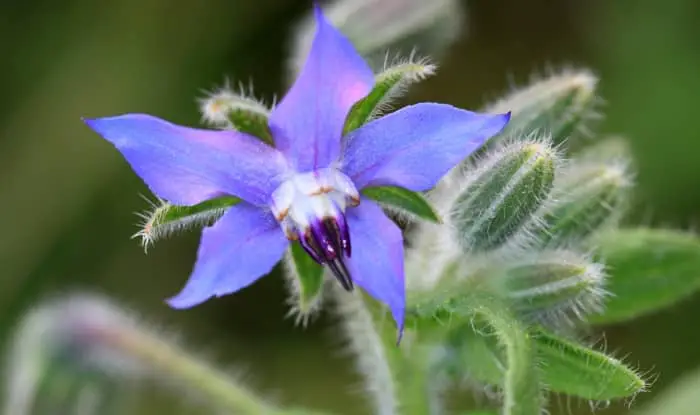
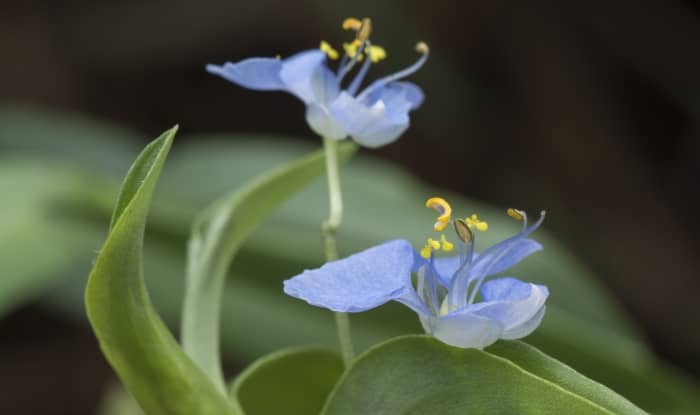
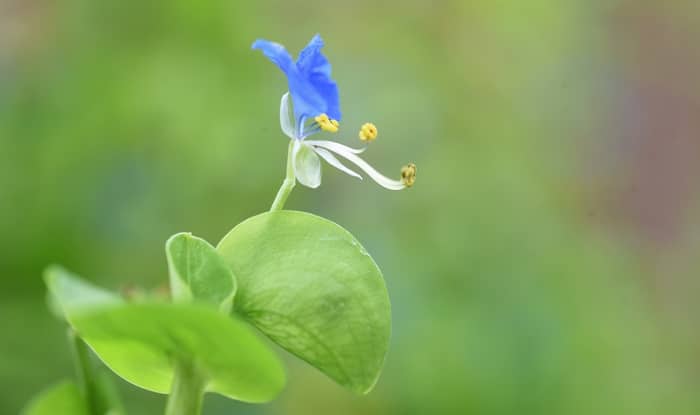
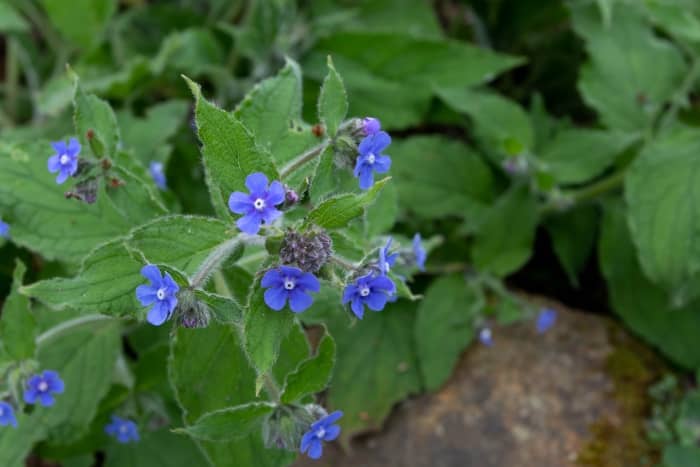
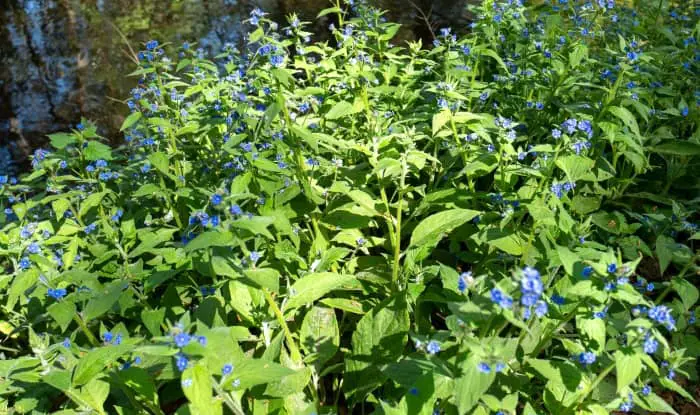
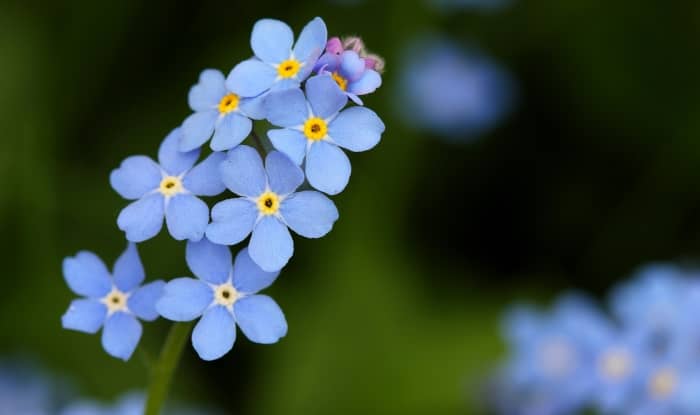
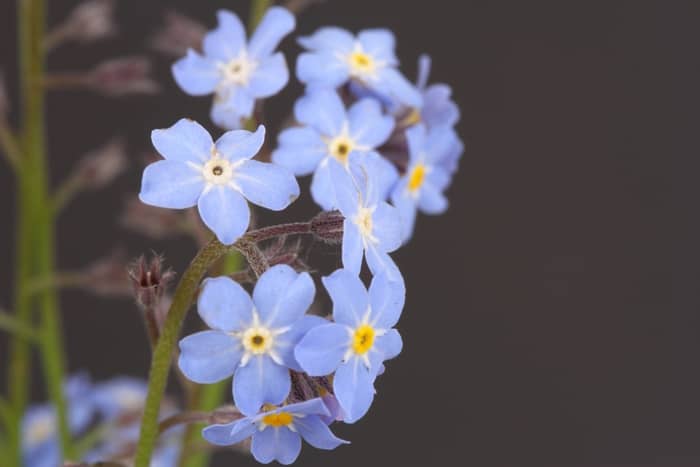

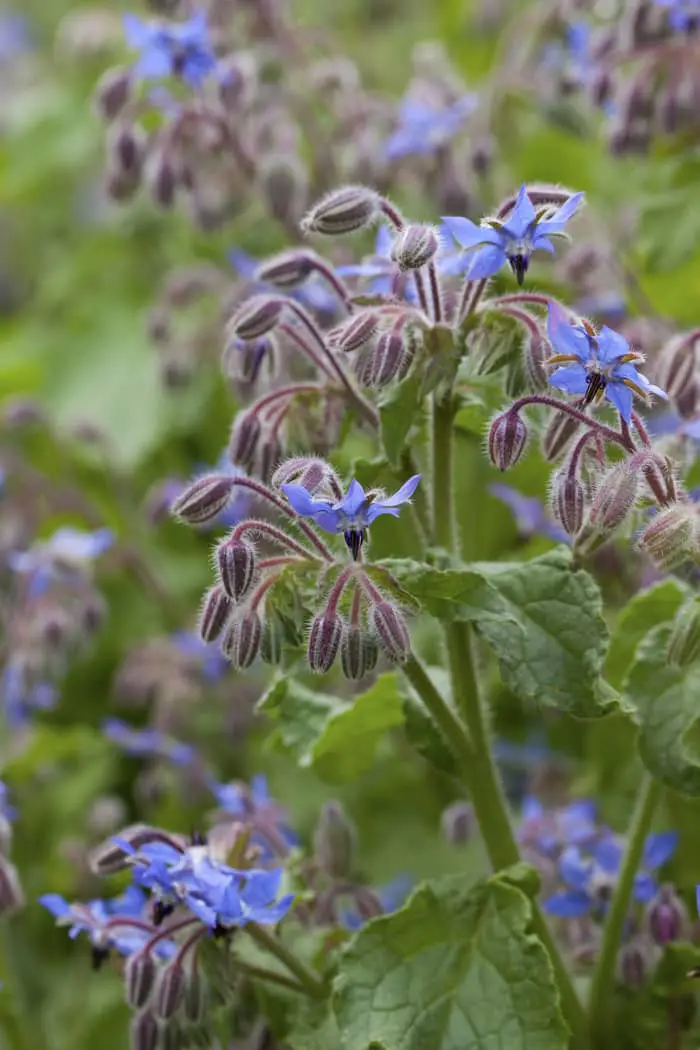
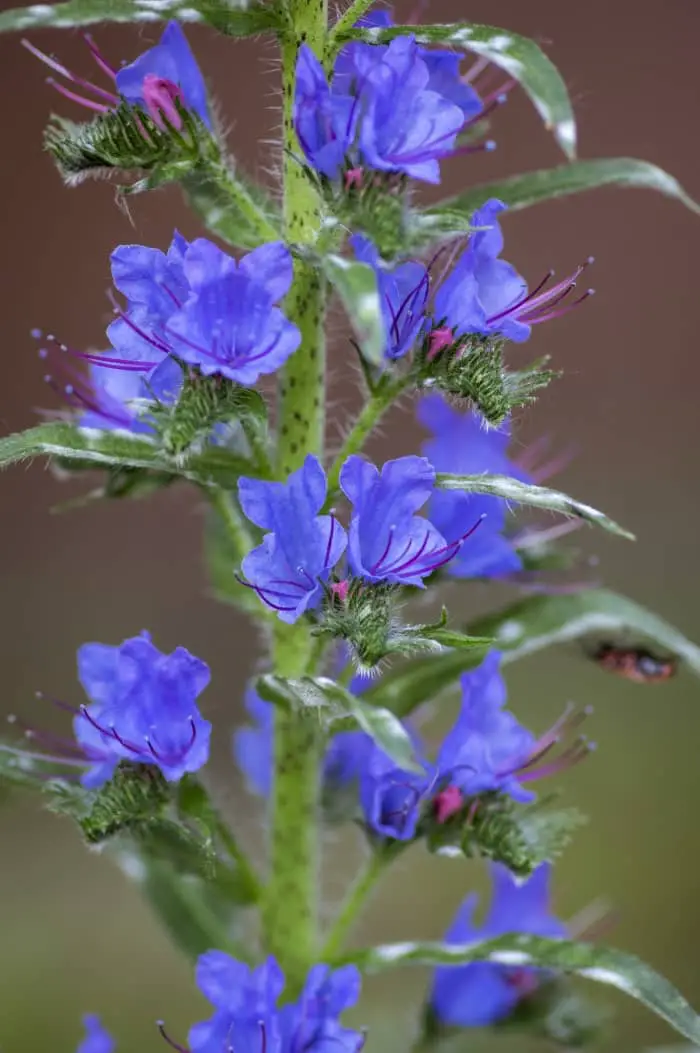
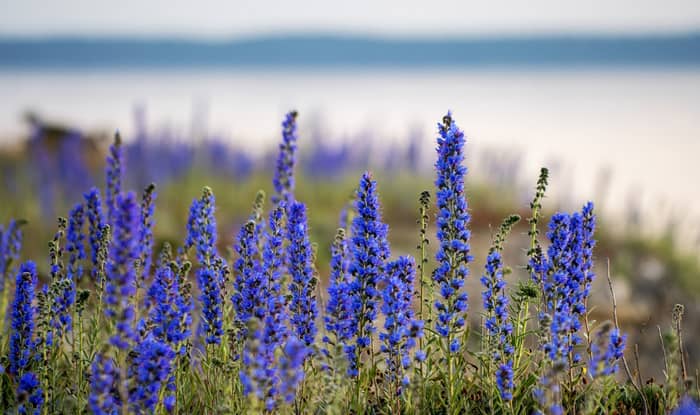
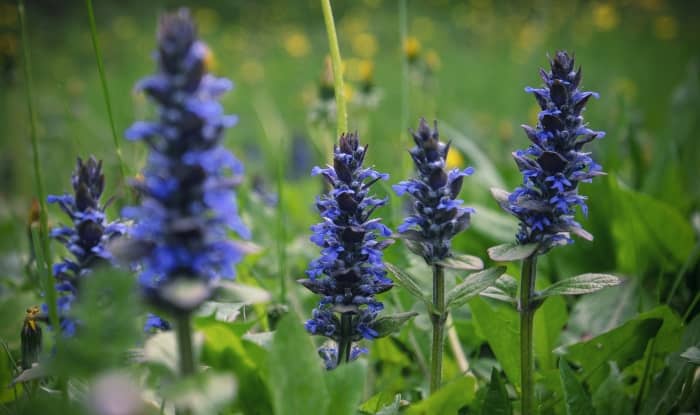
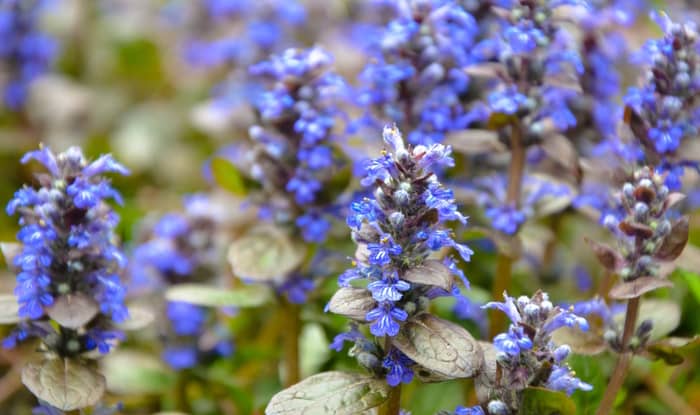
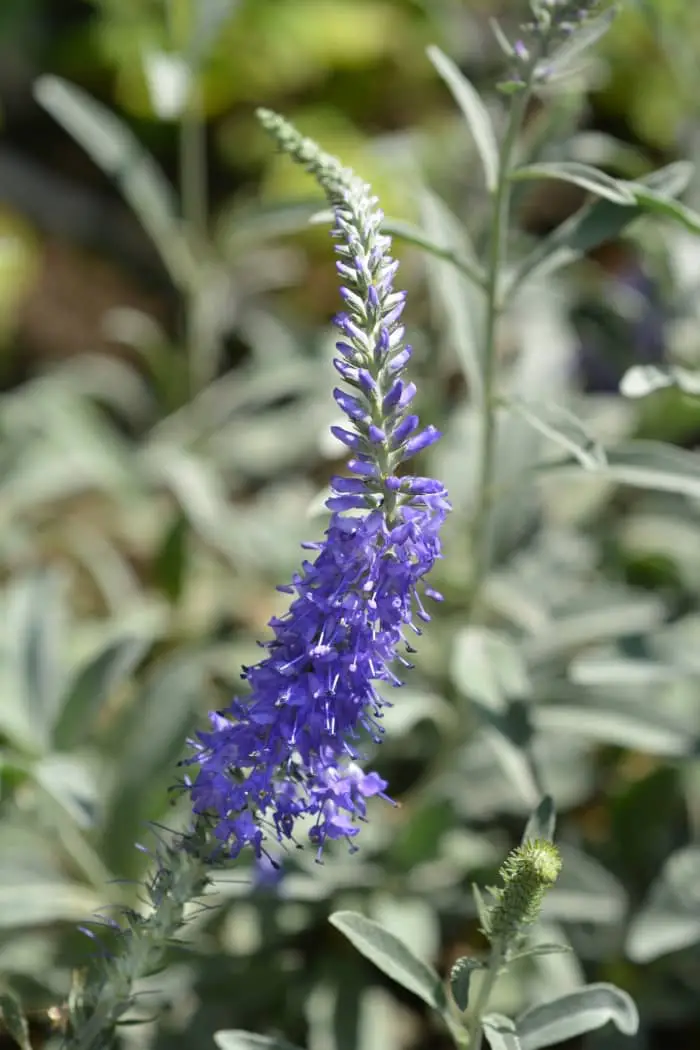
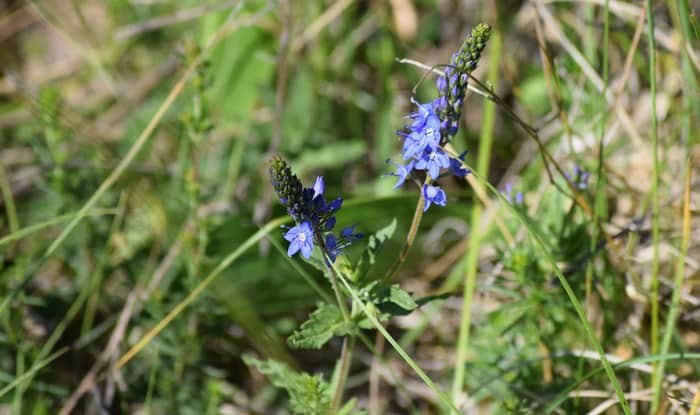
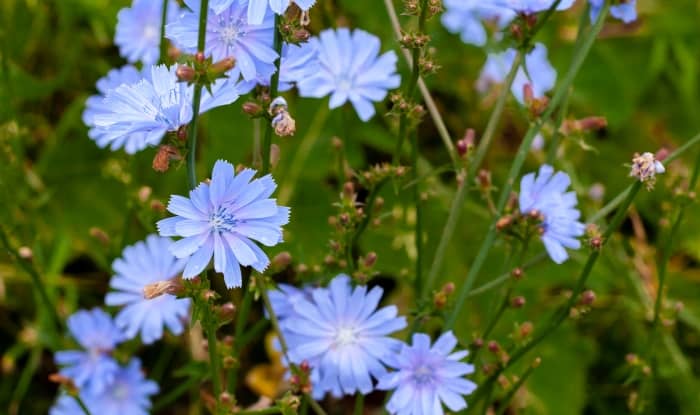
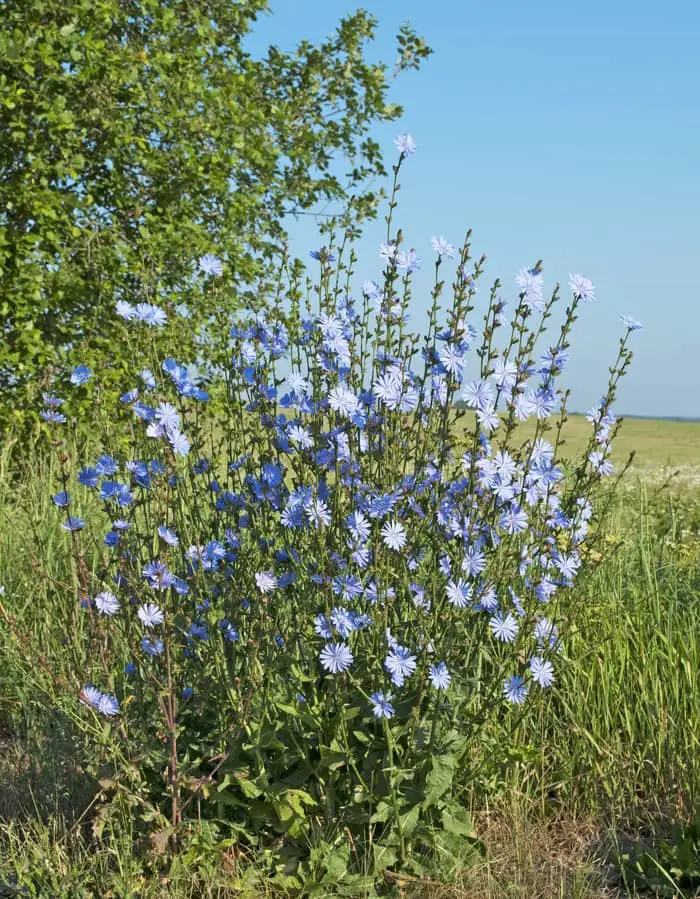
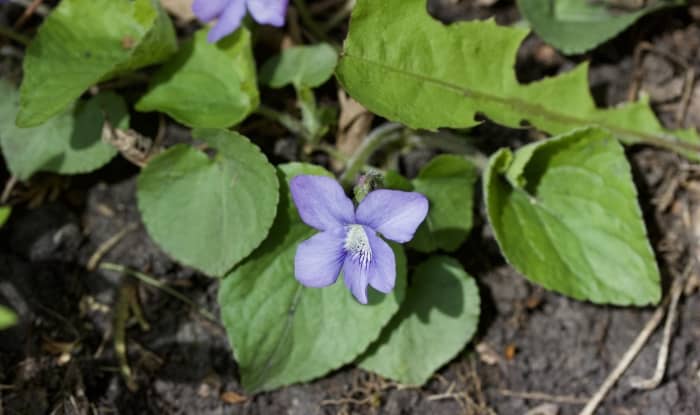
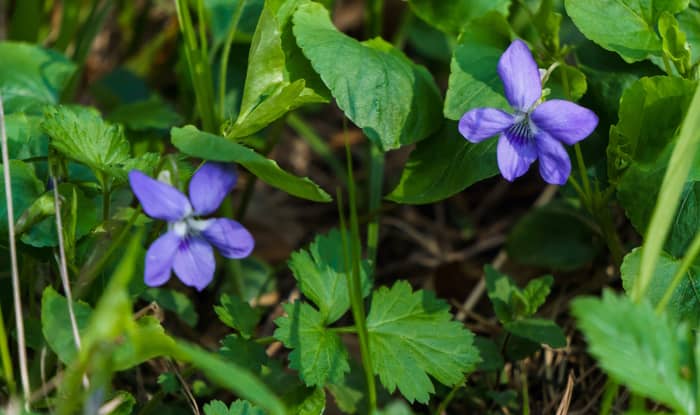
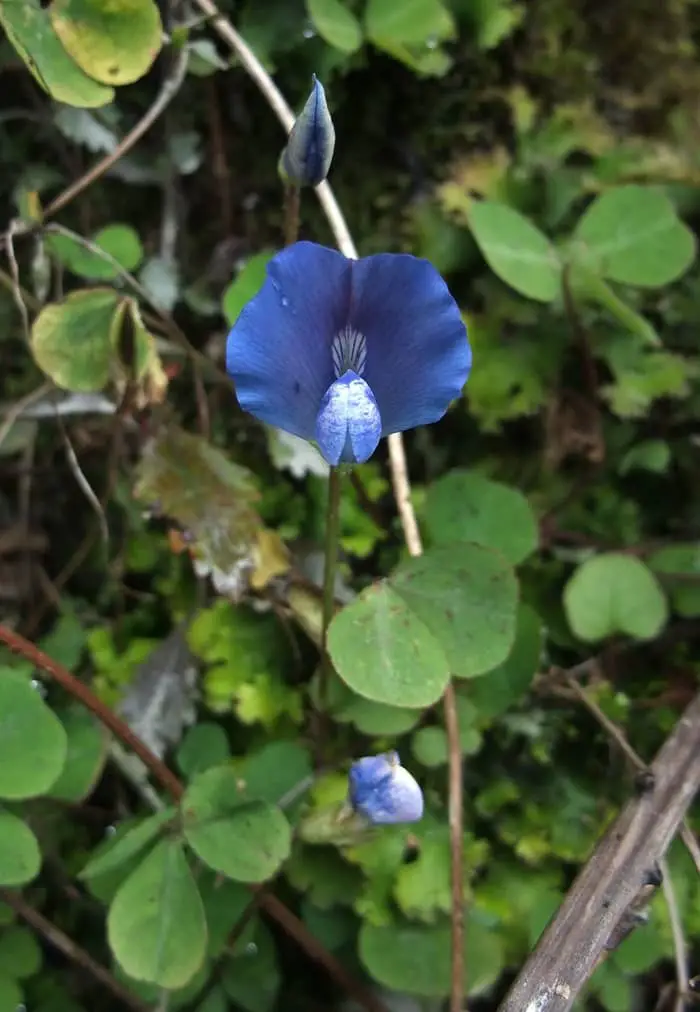
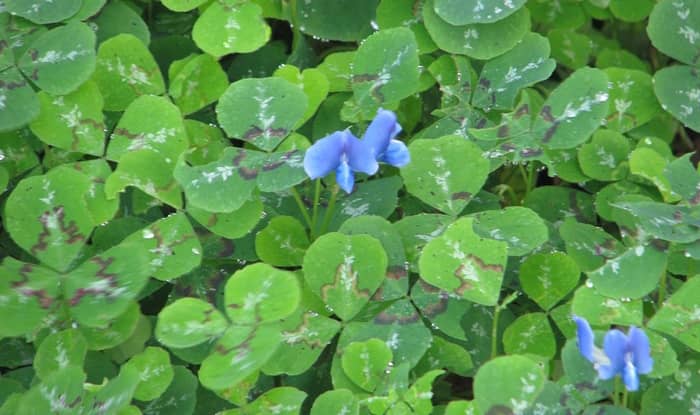
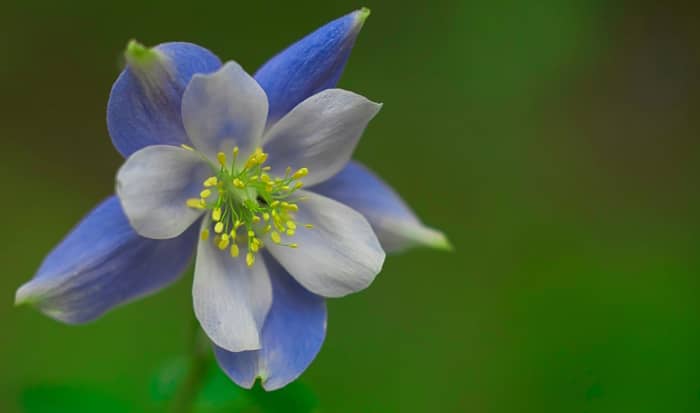
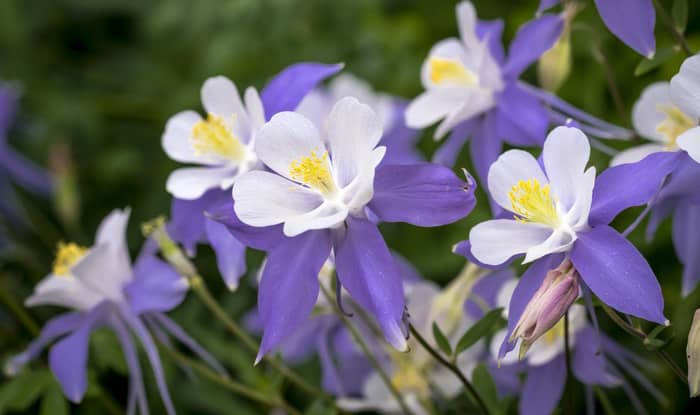
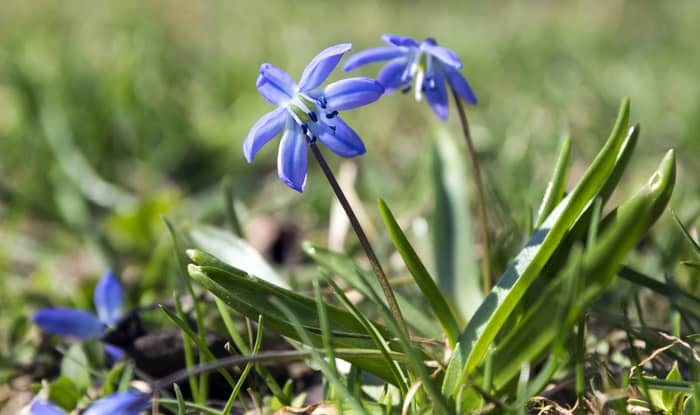
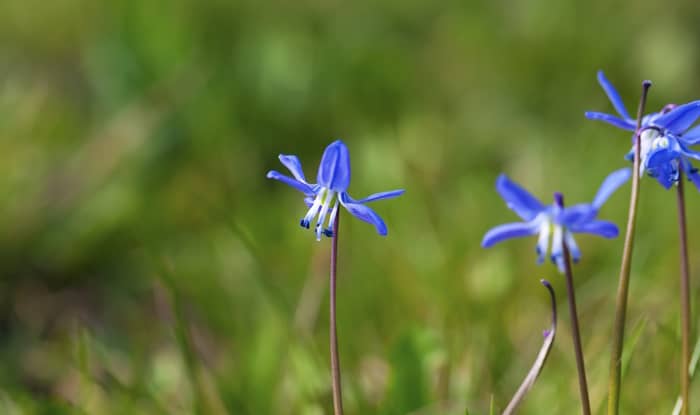


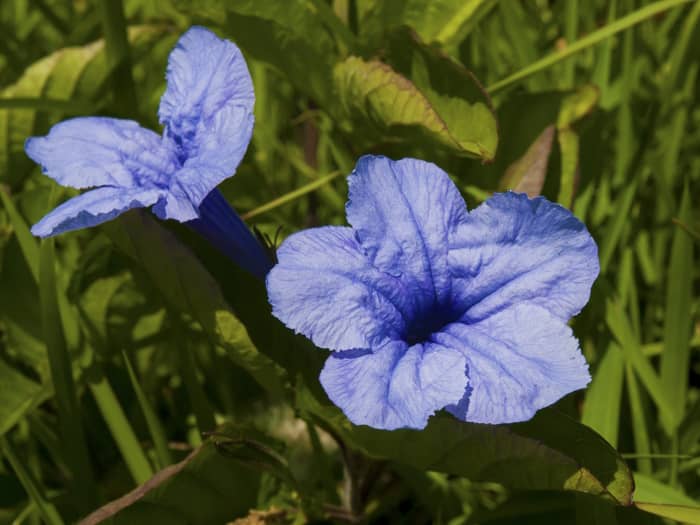
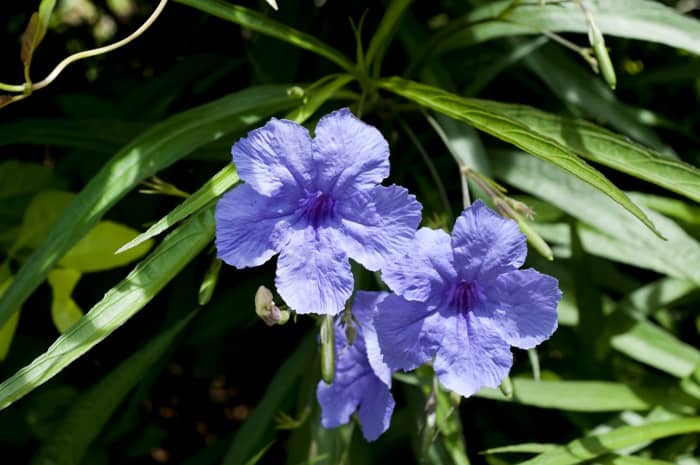
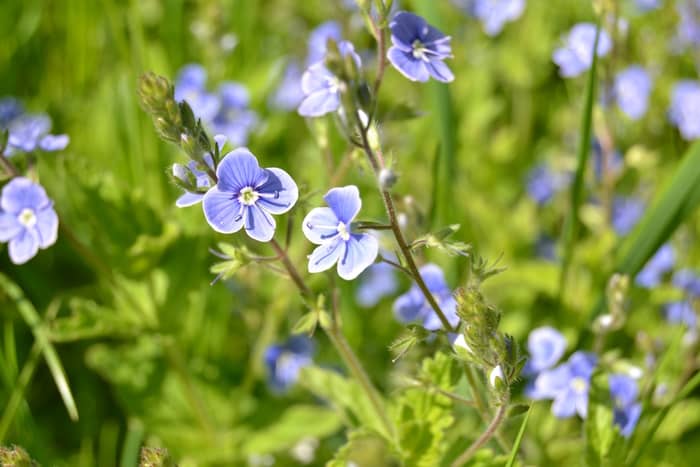
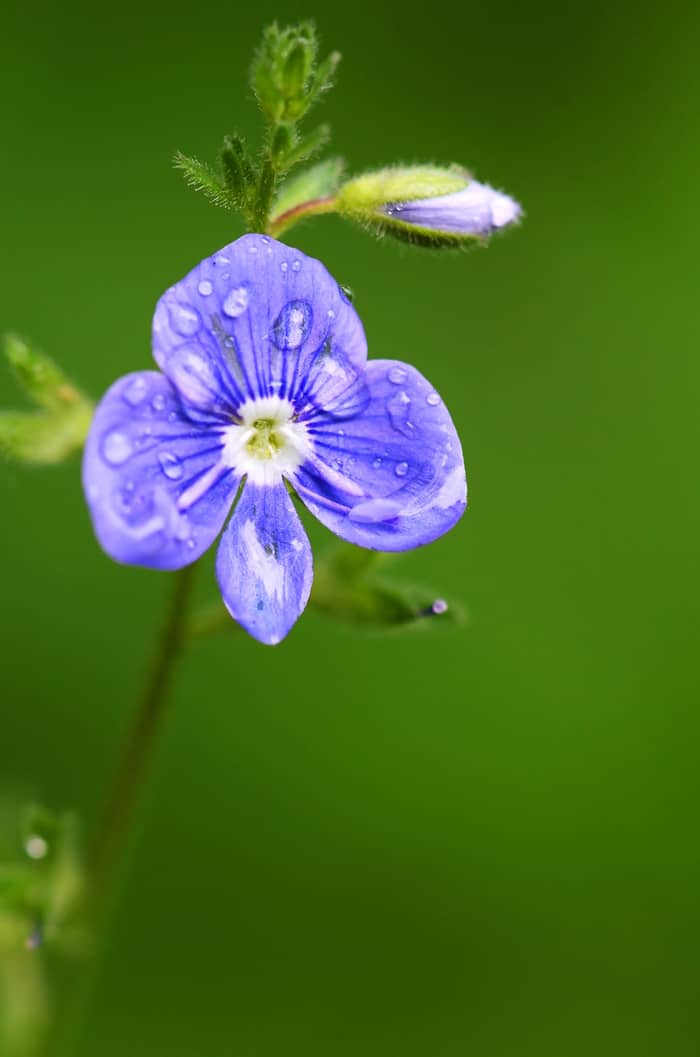
Thank you, at last I know I have Asiata’s dayflower, and I will resort to extremes to get rid of it. Mostly I patrol and pull them while they’re still at one leaf stage.